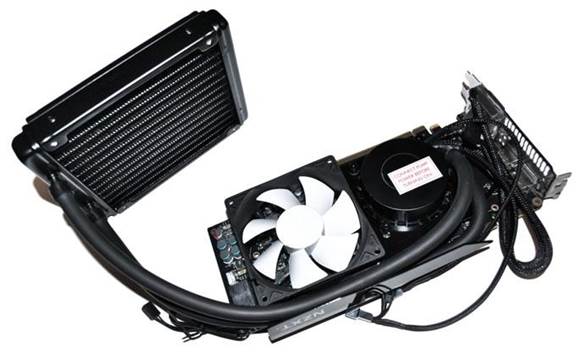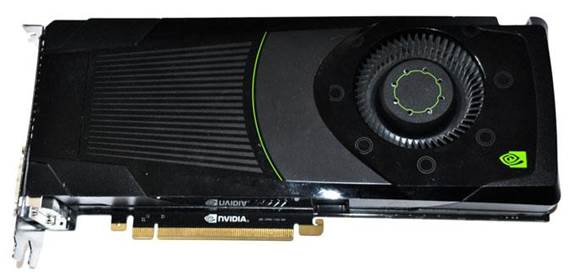Expensive but colder than a
witch's you-know-what
NZXTS G10 Bracket is a unique GPU cooler that takes
advantage of one incontrovertible fact of today's liquid-cooling market: Most
of the coolers out there are designed by Asetek. This snazzy adapter lets you
take any Asetek CPU cooler (yes, we said CPU cooler) and bolt it onto your GPU
to deliver a level of cooling performance that is simply not possible with an
aftermarket air cooler.

NZXT G10 GPU Bracket
The brackets, which are available in black, red, and white,
attach to a wide variety of GPUs, including all the AMD and Nvidia cards made
in the past several years, with the only exceptions being some Radeon R9 280
and HD 79xx cards. We actually failed to read this little note in the
instructions and installed it on a Radeon HD 7970 at first, only to see GPU
temps skyrocket to 100 C within five seconds of a load being placed on the
card, indicating insufficient contact between the water block and the GPU die.
NZXT notes that some GPUs have recessed dies, and will need a shim, which are
available online for $4. As the saying goes, “Ain’t nobody got time for that!”
so we moved onto a Radeon R9 290X for testing. We figured it was the best
candidate anyway, since it's notoriously hot and loud. If the G10 could tame
that wild beast, it could certainly handle a cooler-running Kepler board, as
well. Cooling was provided by a Kraken X40 CPU cooler, also by NZXT, but any
Asetek-based CPU cooler would work, including models made by Thermaltake,
Corsair, Zalman, and Antec.
Installation was painless. We removed the stock cooler,
fitted four long screws through a backplate, poked it through the board, then
lowered the G10 bracket (with the water block attached) onto the GPU heat
spreader. Four nuts were secured to the screws, and it was in place. Next, we
mounted the radiator and fan inside our case, then connected the 140mm fan to a
header on the bracket. There’s a VRM fan on the G10, and it also attached to a
header on the G10. Power for the pump and the fans comes from a lead that
connects to a USB header on the mobo. Overall, the installation was
straightforward and easy to follow.

NZXT G10’s parts
Upon our first boot, we noted that idle temps were around 40
C, which is very low. Once we began to push the card, instead of rising to its
normal 94 C, we saw temps slowly rise up to around 53 C and then stay there
throughout testing. This let us overclock the card to a scorching 1,120MHz,
netting a 10 percent gain in performance. It’s also extremely quiet, and with
the Kraken Kontrol software we were able to fine-tune the fan curve, or select
modes such as Extreme or Quiet.
Overall, the G10 is the best GPU cooler we’ve ever tested.
It’s expensive, sure, but performance like this is never cheap. The only fly in
the ointment is that after-market cards from Asus, EVGA, Gigabyte, et al, cost
less, allow similar if not better overclocking, and are almost as quiet.
Obviously, if you’re running a closed-loop CPU cooler, you’ll also want to make
sure you can fit two coolers in the case. If you must do water, this is the way
to go. Thrifty upgraders will want to just go with a GPU with a non-reference
cooler, though.

NZXT G10’s underside
|
Specifications
·
Price: $30
·
Dimensions: 177 (W) x 32.5 (H) x 110.6 (D) mm
·
Fan Bearing: Sleeve
·
Fan Connector: 3-Pin
·
Compatibility: Nvidia GTX 780 Ti, 780, 770, 760, Titan, 680,
670, 660Ti, 660, 580, 570, 560Ti, 560, 560SE ; AMD R9 290X, 290, 280X, 280,
270X, 270 HD7970, 7950, 7870, 7850, 6970, 6950, 6870, 6850, 6790, 6770, 5870,
5850, 5830; Kraken X60, Kraken X40; Corsair H105, H110, H90, H75, H55 , H50;
Antec Kuhler H2O 920V4, Kuhler H2O 620V4, Kuhler H2O 920, Kuhler H2O 620;
Thermaltake Water 3.0 Extreme, Water 3.0 Pro, Water 3.0 Performer, Water 2.0
Extreme, Water 2.0 Pro, Water 2.0 Performer; Zalman LQ-320, LQ-315, LQ-310
·
Fan Dimensions: 92 x 92 x 25 mm
·
Fan Input Power: 2.16W
·
Fan Current: 0.18A
·
Fan Speed: 1500 ± 10% R.P.M.
·
Fan Voltage: 12V DC
·
Warranty: 2 Years
Verdict
·
Pros: Impressive performance; comes in three colors; easy
install.
·
Cons: Only worth it for reference coolers; expensive compared
to aftermarket GPU cooler.
·
Rating: 9/10
|